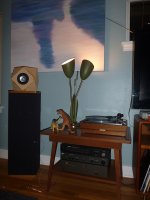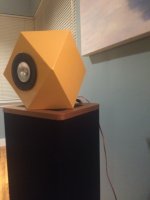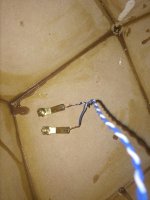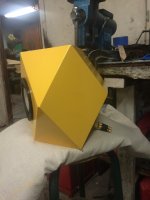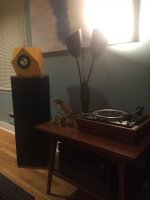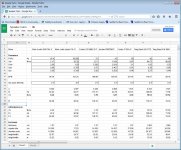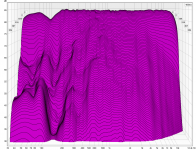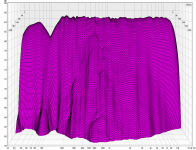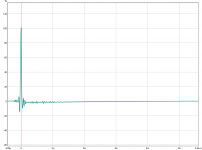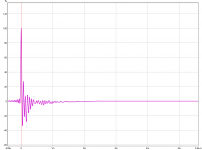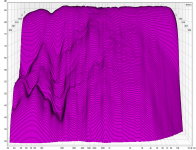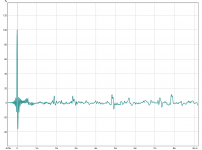On some advice from a friend I just ran a pair of twisted wire from a network cable through a small hole in the back of each speaker. Hooked them up to my NAD 1130 & 2140 and Dual 1218. Placed them on top of my Vandersteen 2C's. And now I'm listening...
Not bad. Nothing weird of off. Maybe not enough low lows? Otherwise sound decent. Crisp. Things like voices and bells and ringing things sound great. I have no idea what words to use or even how to listen really. All I can say is if this all I had I'd be pleased. And having made them myself I'm also biased.
See picture
Not bad. Nothing weird of off. Maybe not enough low lows? Otherwise sound decent. Crisp. Things like voices and bells and ringing things sound great. I have no idea what words to use or even how to listen really. All I can say is if this all I had I'd be pleased. And having made them myself I'm also biased.
See picture
Attachments
Congrats. It looks like the bass eq on your NAD 1130 might be well suited to flatten the bass response of the speakers (they will definitely need some lift in the bottom octave(s)). As the drivers continue to break in, try cranking that bass knob more and more; I think you will be surprised at both the quality and quantity of bass.
All done. Painted crudely kinda. With binding posts. Still sound good. I'll try out some stuffing in them next.
Great job and thanks once again for the update. I'm looking forward to hearing your opinion on the effects of stuffing. I only tried it with a single speaker and I had mixed feelings about it. I'd like to try panel damping instead but I can't decide between the adhesive vinyl sheets and the spray-on stuff.
Seriously beautiful and solid job on your hypercubes mattsmith! Yes crank up the bass like gmad said. But I like what you said about the high end and transients. They DO a fine job on that stuff. Often the low end needs some help especially with the smaller drivers -- just a matter of piston diameters -- but I believe and hope you will find them not only pieces of pure geometric art to show off visually, but sweet candy to the ears. And there's nothing wrong with being proud of something you built. I've met lots of people who couldn't do great work like that on their own. Respect!
I still like listening to these. Also I have all the things to test the frequency response and will try to get that done this week. I have a few other things to try out too. Some polyfill to try out stuffing them with and a cheep subwoofer to try and fill in the low end.
In the meantime I'm thinking about how to get more low end naturally from the hypercube design, without having to adjust my preamp so much because perhaps in the future I'll build a preamp without any EQ ability. These aren't that loud, so I'm thinking about building another set, trying to maximize for the low end and increase volume capacity....
Soooooo, I took some drivers I could find online that looked promising. Made a spreadsheet with the various drivers, and then calculated a theoretical f3. The idea is that the lowest f3 will have the best natural low end. Is this right?
Attached is the spreadsheet. I also sized the enclosure using AJDesigner.exe. I wish I knew the equations that was using btw. Even the largest enclosure for the 8" Tang Band W8-1808 is only 20" tall/wide. I also think the Tang Band W8-1808 looks the most promising.
The 8" Tang Band W8-1808 isn't cheep at about $200 each. Any other good recommendations for drivers would be greatly appreciated.
Thanks for reading along and encouraging me, everyone!
In the meantime I'm thinking about how to get more low end naturally from the hypercube design, without having to adjust my preamp so much because perhaps in the future I'll build a preamp without any EQ ability. These aren't that loud, so I'm thinking about building another set, trying to maximize for the low end and increase volume capacity....
Soooooo, I took some drivers I could find online that looked promising. Made a spreadsheet with the various drivers, and then calculated a theoretical f3. The idea is that the lowest f3 will have the best natural low end. Is this right?
Attached is the spreadsheet. I also sized the enclosure using AJDesigner.exe. I wish I knew the equations that was using btw. Even the largest enclosure for the 8" Tang Band W8-1808 is only 20" tall/wide. I also think the Tang Band W8-1808 looks the most promising.
The 8" Tang Band W8-1808 isn't cheep at about $200 each. Any other good recommendations for drivers would be greatly appreciated.
Thanks for reading along and encouraging me, everyone!
Attachments
mattsmith thanks sharing your build, in looking for more low end have you seen this thread http://www.diyaudio.com/forums/full-range/265915-hyperfast-hypercube-based-2-way.html.
mattsmith,
These come to mind as an alternative to the Tang Band 8" drivers:
https://www.madisoundspeakerstore.com/approx-8-fullrange/seas-prestige-fa22rcz-h1597-08-8-fullrange/
These come to mind as an alternative to the Tang Band 8" drivers:
https://www.madisoundspeakerstore.com/approx-8-fullrange/seas-prestige-fa22rcz-h1597-08-8-fullrange/
Just want to share a couple of additional measurements...
The impulse response measurements were made with the mic 3" from the phase plug and show the response with no eq, flat target eq, and with an additional lowpass filter (roughly -4db at 16k based on a first order hold response with 44k sampling) for those who like more of a "vinyl" presentation. These were previously shown in the HyperFast thread.
The waterfall plots show the decay as measured from the listening position (just over 5' from the speakers). These are showing the corrected response using the "minimal" preset of DRC which is mostly just correcting the direct sound and a little bit of the room effect below ~500hz. The first one shows a 30db decay over 250ms and the second one shows 60db over 400ms. The response is very similar from both channels since I am fortunate enough to have symmetrical speaker positioning with respect to the room boundaries.
The impulse response measurements were made with the mic 3" from the phase plug and show the response with no eq, flat target eq, and with an additional lowpass filter (roughly -4db at 16k based on a first order hold response with 44k sampling) for those who like more of a "vinyl" presentation. These were previously shown in the HyperFast thread.
The waterfall plots show the decay as measured from the listening position (just over 5' from the speakers). These are showing the corrected response using the "minimal" preset of DRC which is mostly just correcting the direct sound and a little bit of the room effect below ~500hz. The first one shows a 30db decay over 250ms and the second one shows 60db over 400ms. The response is very similar from both channels since I am fortunate enough to have symmetrical speaker positioning with respect to the room boundaries.
Attachments
Thanks BYRTT, as always, for your thoughtful and helpful response.
Some things I want to try in the future are:
--placing the speakers in the 45 deg upward position and re-equalizing for a more even power response through the top octaves and more consistent frequency response for two listeners.
--applying vinyl damping sheets to inside and outside surfaces of the enclosures and comparing the effect to the open cell foam I used to eliminate the 1.5k ringing from the nearfield impulse response measurement (I'm still listening without the foam).
I'm still enjoying these very much. 🙂
Some things I want to try in the future are:
--placing the speakers in the 45 deg upward position and re-equalizing for a more even power response through the top octaves and more consistent frequency response for two listeners.
--applying vinyl damping sheets to inside and outside surfaces of the enclosures and comparing the effect to the open cell foam I used to eliminate the 1.5k ringing from the nearfield impulse response measurement (I'm still listening without the foam).
I'm still enjoying these very much. 🙂
Welcome, admire your skills and setup thanks goes indeed your way for sharing stuff.
Sounds good idea make the trials by damping sheets and compare, saw somewhere xrk971 tried some outside dampening a TC9FD test beautiful clean IR and therefor have ordered some of these bats to see what happens when box wrapped into this from front to back.
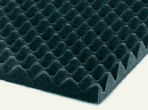
Your thoughts EQ a more even response at top works for me a pair metal A10.2 to fill hole room and go around, but the most high end and ego is flat EQ close range on axis listening at these relative bigger cones having Sd 0,0088 sq m, your RS100 guess have better build in dispertion being 0,0035 sg m.
Think you good at tweaking and saw your nice suggestion minded guitar setup #9 this thread http://www.diyaudio.com/forums/full...e-speaker-extension-high-end.html#post4203990, thanks the tip.
Speaking tweaking have you tried electric dampening correction network for the rising induction and resonance impedance. Can also tried tweak on a guitar speaker, on my A10.2 have a RLC and a couple RC networks to make the final blue impedance correction in the plot beneath. Frequency response have minimal change but cone really stops springs around in the area it has high impedance to amps low z. On the A10.2 it takes some ringing both listenable and seen at IR. The drawback or what to call it is impedance measurement has to be done in final box and not in free air, which means changing a little on the box even inside dampening means new impedance measurement and filter values.
Sounds good idea make the trials by damping sheets and compare, saw somewhere xrk971 tried some outside dampening a TC9FD test beautiful clean IR and therefor have ordered some of these bats to see what happens when box wrapped into this from front to back.

Your thoughts EQ a more even response at top works for me a pair metal A10.2 to fill hole room and go around, but the most high end and ego is flat EQ close range on axis listening at these relative bigger cones having Sd 0,0088 sq m, your RS100 guess have better build in dispertion being 0,0035 sg m.
Think you good at tweaking and saw your nice suggestion minded guitar setup #9 this thread http://www.diyaudio.com/forums/full...e-speaker-extension-high-end.html#post4203990, thanks the tip.
Speaking tweaking have you tried electric dampening correction network for the rising induction and resonance impedance. Can also tried tweak on a guitar speaker, on my A10.2 have a RLC and a couple RC networks to make the final blue impedance correction in the plot beneath. Frequency response have minimal change but cone really stops springs around in the area it has high impedance to amps low z. On the A10.2 it takes some ringing both listenable and seen at IR. The drawback or what to call it is impedance measurement has to be done in final box and not in free air, which means changing a little on the box even inside dampening means new impedance measurement and filter values.
Attachments
Just want to share a couple of additional measurements...
The impulse response measurements were made with the mic 3" from the phase plug and show the response with no eq, flat target eq, and with an additional lowpass filter (roughly -4db at 16k based on a first order hold response with 44k sampling) for those who like more of a "vinyl" presentation. These were previously shown in the HyperFast thread.
The waterfall plots show the decay as measured from the listening position (just over 5' from the speakers). These are showing the corrected response using the "minimal" preset of DRC which is mostly just correcting the direct sound and a little bit of the room effect below ~500hz. The first one shows a 30db decay over 250ms and the second one shows 60db over 400ms. The response is very similar from both channels since I am fortunate enough to have symmetrical speaker positioning with respect to the room boundaries.
Very nice! No you make me want to go take some more near field measurements 😀. Do you have separate measurements left/right from that listening position?
Hi BYRTT,
I have thought about a network but since the DSP seems to work so well, I haven't been motivated to try it yet.
You might be interested in some specifics of my measurement-playback method. I use a non-oversampling dac and run my measurement sweep at 44.1k. As you may be aware, the zero order hold function of the converter causes a drop in in amplitude with increasing frequency (-4db at the Nyquist frequency). My philosophy is that the most natural way to listen to digital recordings involves (among other things) preserving this slight drop in high frequencies (minimizing the ringing). However, I also like to upsample my data to 176.4k so that there is no chance of audible quantization distortion (mainly during very quiet passages with early digital classical music recordings) since my DSP eats up a couple of bits of resolution. Since DRC is compensating for the zoh effect of 44.1k sampling but I'm listening at 176.4, the initial result is a subtle rise in the top octave rather than a drop. To solve this I created a 176.4k wav file with 4 samples at max amplitude (to mimic a single sample spike at 44.1k) and convolved it with itself. This new file mimics a first order hold response at 44.1k and brings the final response back to that of the non-oversampled zoh response. Finally, as of late, I have been using sox upsampler in foobar with the bandwidth set to 80%, which provides a more gentle lowpass starting at 16-17k rather than a very sharp filter at 20k. The final system impulse response looks and sounds very good.
I have thought about a network but since the DSP seems to work so well, I haven't been motivated to try it yet.
You might be interested in some specifics of my measurement-playback method. I use a non-oversampling dac and run my measurement sweep at 44.1k. As you may be aware, the zero order hold function of the converter causes a drop in in amplitude with increasing frequency (-4db at the Nyquist frequency). My philosophy is that the most natural way to listen to digital recordings involves (among other things) preserving this slight drop in high frequencies (minimizing the ringing). However, I also like to upsample my data to 176.4k so that there is no chance of audible quantization distortion (mainly during very quiet passages with early digital classical music recordings) since my DSP eats up a couple of bits of resolution. Since DRC is compensating for the zoh effect of 44.1k sampling but I'm listening at 176.4, the initial result is a subtle rise in the top octave rather than a drop. To solve this I created a 176.4k wav file with 4 samples at max amplitude (to mimic a single sample spike at 44.1k) and convolved it with itself. This new file mimics a first order hold response at 44.1k and brings the final response back to that of the non-oversampled zoh response. Finally, as of late, I have been using sox upsampler in foobar with the bandwidth set to 80%, which provides a more gentle lowpass starting at 16-17k rather than a very sharp filter at 20k. The final system impulse response looks and sounds very good.
Very nice! No you make me want to go take some more near field measurements 😀. Do you have separate measurements left/right from that listening position?
Here are the waterfalls from the other speaker as well as the impulse response from the listening spot. The slight differences between these waterfalls and the other channel shown previously could be partly due to the room asymmetry behind the listening spot.
Attachments
Still quite a similar result for both channels. If you can find a way to fill in the dip at ~100 Hz, it seems the dip is slightly different from one channel to the other.
What different placement options did you play with if any? Should be interesting to see what the planned 45 degree upwards firing speaker does.
I tried a few different on axis/off axis angles on mine but still like my current 15 degree toe in the best. It crosses the speakers behind me.
I tried crossing in front for a wider sweet spot but lost the width that currently exceeds the width of the the speakers.
What different placement options did you play with if any? Should be interesting to see what the planned 45 degree upwards firing speaker does.
I tried a few different on axis/off axis angles on mine but still like my current 15 degree toe in the best. It crosses the speakers behind me.
I tried crossing in front for a wider sweet spot but lost the width that currently exceeds the width of the the speakers.
Last edited:
I have not experimented at all with placement with the hypercubes, I just put them where my previous speakers seemed to work best. Interestingly enough, I didn't notice the dip with those speakers which used up-firing woofers (in a cylindrical enclosure). They did have a passive radiator at the bottom but I think the tuning was too low for that to explain it. Anyway, the bass sounds very good to me right now despite the dip but we'll see what happens with a different position.
Welcome, admire your skills and setup thanks goes indeed your way for sharing stuff.
Sounds good idea make the trials by damping sheets and compare, saw somewhere xrk971 tried some outside dampening a TC9FD test beautiful clean IR and therefor have ordered some of these bats to see what happens when box wrapped into this from front to back.
View attachment 464238
Your thoughts EQ a more even response at top works for me a pair metal A10.2 to fill hole room and go around, but the most high end and ego is flat EQ close range on axis listening at these relative bigger cones having Sd 0,0088 sq m, your RS100 guess have better build in dispertion being 0,0035 sg m.
Think you good at tweaking and saw your nice suggestion minded guitar setup #9 this thread http://www.diyaudio.com/forums/full...e-speaker-extension-high-end.html#post4203990, thanks the tip.
Speaking tweaking have you tried electric dampening correction network for the rising induction and resonance impedance. Can also tried tweak on a guitar speaker, on my A10.2 have a RLC and a couple RC networks to make the final blue impedance correction in the plot beneath. Frequency response have minimal change but cone really stops springs around in the area it has high impedance to amps low z. On the A10.2 it takes some ringing both listenable and seen at IR. The drawback or what to call it is impedance measurement has to be done in final box and not in free air, which means changing a little on the box even inside dampening means new impedance measurement and filter values.
I actually used highly porous scouring pads surrounding the driver on the baffle. It's interesting but this simple trick really makes then detail on trabsients much cleaner sounding because it smooths the otherwise rippled mid and HF response from diffraction.
It's different than openncell foam as it is more like reticulated hard fibers.
Amazon.com: Scotch-Brite Pads, 6 x 9: Electronics
- Status
- Not open for further replies.
- Home
- Loudspeakers
- Full Range
- Hypercube Loudspeakers
